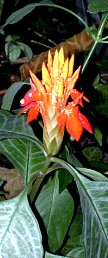 |
Knowing that a plant's roots need both water and exchange of gases, what can be done to be sure that the growing medium supplies both? |
|
Picture the spaces between the solid particles of a soil. If the particles are large and of an irregular shape they will lie together with larger spaces than those left when small particles are involved. Think of some familiar objects (even if they are spheres): a large garbage can filled with basket balls would leave much more space unoccupied in the can than would be the case if you had filled the can with golf balls. If you added water to the cans, you could put more into the can with basket balls than into the one with golf balls. Exactly the same is true with soil particles: a coarse sandy soil has more air space than one made up of clay particles which are many times smaller than a grain of sand. Continuing to think of our garbage cans full of water and balls, if we now make a hole in the bottom of each can, a lot of water will run out. As it does, the spaces between the balls refill with air. But if we had measured how much water went in with the basket balls and with the golf balls, we would find that almost all ran out of the basket ball can, but not quite all came out of the golf ball set up. This is because some water stayed as wetness on the surface of each ball. If our containers had been comparing a pot of coarse sand with a pot of clay, the difference in the amount held would have shown up even more, because the spaces between the particles of clay are so small that some of them stay filled with water. This is important because what it says is that water added to sand will almost all drain through, while water added to clay will mostly drain through but will leave some behind in the smaller spaces. At least part of this will be available to plant roots. If you want to know the physics of this, it is that each molecule of water is attracted to objects around it. This force is called adhesion when the water molecules stick to the surface of the soil particles, and cohesion when they stick to each other. The water drains as long as the downwards force due to gravity is stronger than the forces of adhesion and cohesion. The cohesive forces are only strong enough to hold water in tiny spaces, which is why the big spaces drain. The way in which plant roots take in water uses a different mechanism, so that the film of water on the surface of soil particles and the water in quite tiny spaces is available to them. The ideal growing medium, then, should have a mixture of larger and smaller spaces so that some drain freely, giving the roots air, and some hold water which the roots can use. You can specify this mix of pore sizes by careful mixing of the materials that go into your growing medium.
|
|